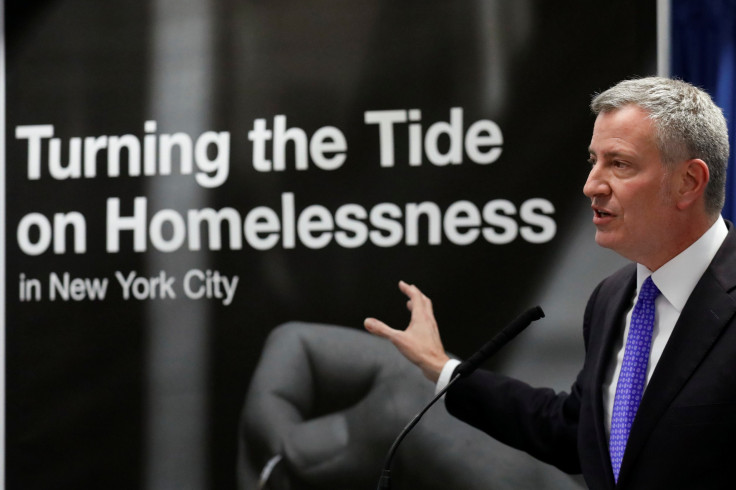Homelessness In New York: Mayor Announces Plan To Open 90 Shelters For Nation's Largest Homeless Population

New York City Mayor Bill de Blasio unveiled a plan Tuesday to open 90 new homeless shelters across the city’s five boroughs. The mayor’s proposal, which would increase the number of shelters by approximately 30 percent, is expected to be with viewed with heavy scrutiny from community members who believe property values will go down as a result.
Combatting the growing amount of homelessness experienced in New York City in recent years has been a main priority for de Blasio, who is running for re-election as mayor in 2017. De Blasio vowed that his plan would result in 2,500 less people living in the city’s primary homeless shelters by 2023, the New York Times reported Tuesday. There are currently 60,000 people registered to live in primary shelters, compared to roughly 53,000 in 2014; the same year de Blasio was voted into office by campaigning to reduce the number of people living on the streets.
New York City is expected to spend $1.4 billion this year on homeless people living in hotels, apartments and shelters, the New York Daily News reported Friday.
We need to remember how many New Yorkers are one bad break away from being homeless. pic.twitter.com/wsXzcMbKyK
— Mayor Eric Adams (@NYCMayor) March 1, 2017
De Blasio said he hoped to curb homelessness in the city by moving those who were forced to take temporarily refuge in commercial hotel rooms and cluster housing apartments into primary shelters where they can receive professional rehabilitation efforts to someday acquire permanent housing.
De Blasio’s Tuesday plan called for nearly $300 million to be allocated from the city’s budget towards creating “high quality” shelters to completely eliminate the prevalence of hotel rooms and cluster housing in the next five years.
We’re going to deepen our response to homelessness borough-by-borough, neighborhood-by-neighborhood, family-by-family, person-by-person.
— Mayor Eric Adams (@NYCMayor) February 28, 2017
Roughly 18,500 people, who represent almost a third of those registered in the city’s primary shelter, live in these privately owned hotel rooms and cluster apartments that are oftentimes in decrepit conditions.
De Blasio’s plan could face opposition in the City Council, where municipal lawmakers have raised concern about the unequal distribution of homeless centers across the five boroughs. Two hundred and fifteen cluster sites are located in the Bronx, which constitutes 75 percent of those in the city. And half of the commercial hotels where homeless people are placed into are in Queens.
New York City had the largest increase in homelessness of any city in the U.S. between 2009 and 2016, where the number grew 49 percent, the Washington Post reported Dec. 14, 2016.
© Copyright IBTimes 2024. All rights reserved.






















